ASRock Fatal1ty Z77 Professional Review - IDE and Floppy on Z77
by Ian Cutress on May 20, 2012 1:30 PM EST- Posted in
- Motherboards
- ASRock
- Fatal1ty
- Z77
3D Movement Algorithm Test
The algorithms in 3DPM employ both uniform random number generation or normal distribution random number generation, and vary in various amounts of trigonometric operations, conditional statements, generation and rejection, fused operations, etc. The benchmark runs through six algorithms for a specified number of particles and steps, and calculates the speed of each algorithm, then sums them all for a final score. This is an example of a real world situation that a computational scientist may find themselves in, rather than a pure synthetic benchmark. The benchmark is also parallel between particles simulated, and we test the single thread performance as well as the multi-threaded performance.
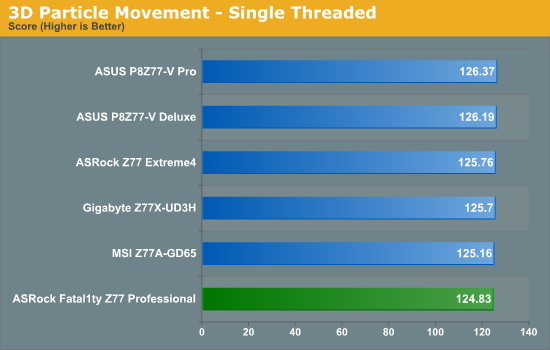
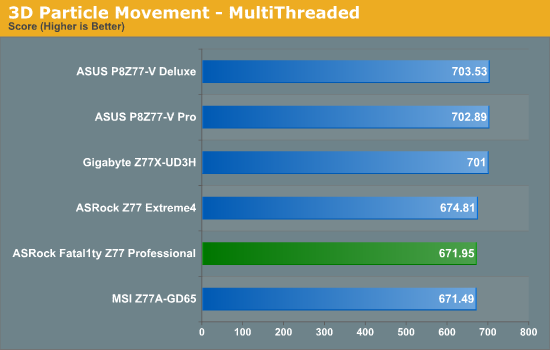
Due to the default overclock enabled option of ASUS and Gigabyte boards, the ASRock unfortunately lags behind noticeably in multithreaded testing. The ASRock should have average single thread performance in comparison, but in our 3DPM test, the Professional comes in with the lowest score.
WinRAR x64 3.93 - link
With 64-bit WinRAR, we compress the set of files used in the USB speed tests. WinRAR x64 3.93 attempts to use multithreading when possible.

As a test that utilizes multithreading where possible, WinRAR exposes how the motherboards react to changes in load and application of turbo modes. The ASRock Fatal1ty Z77 Professional does well here, edging out the ASUS Pro and coming streaks ahead of the Extreme4.
FastStone Image Viewer 4.2 - link
FastStone Image Viewer is a free piece of software I have been using for quite a few years now. It allows quick viewing of flat images, as well as resizing, changing color depth, adding simple text or simple filters. It also has a bulk image conversion tool, which we use here. The software currently operates only in single-thread mode, which should change in later versions of the software. For this test, we convert a series of 170 files, of various resolutions, dimensions and types (of a total size of 163MB), all to the .gif format of 640x480 dimensions.
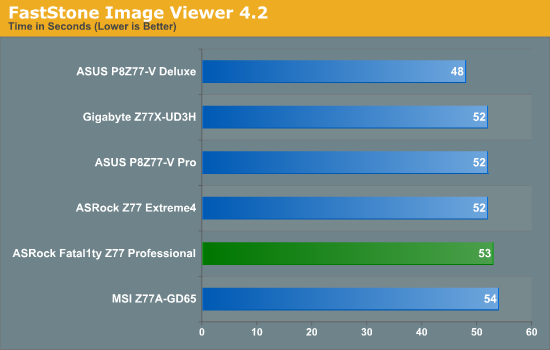
Focusing purely on single threaded performance, the Fatal1ty does not perform too well. With the ASUS Deluxe somehow blitzing the field, nothing is coming close.
Xilisoft Video Converter
With XVC, users can convert any type of normal video to any compatible format for smartphones, tablets and other devices. By default, it uses all available threads on the system, and in the presence of appropriate graphics cards, can utilize CUDA for NVIDIA GPUs as well as AMD APP for AMD GPUs. For this test, we use a set of 32 HD videos, each lasting 30 seconds, and convert them from 1080p to an iPod H.264 video format using just the CPU. The time taken to convert these videos gives us our result.
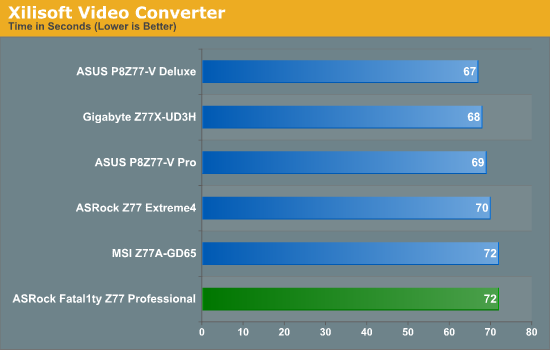
As Xilisoft stresses all cores all of the time, the ASUS and Gigabyte boards have the advantage with that default overclock in multithreaded load. As a result, the Professional lags behind a touch.
x264 HD Benchmark
The x264 HD Benchmark uses a common HD encoding tool to process an HD MPEG2 source at 1280x720 at 3963 Kbps. This test represents a standardized result which can be compared across other reviews, and is dependant on both CPU power and memory speed. The benchmark performs a 2-pass encode, and the results shown are the average of each pass performed four times.
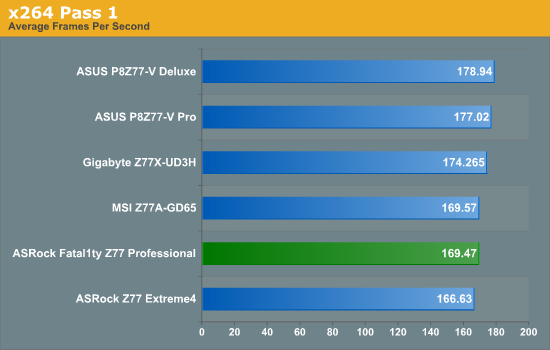
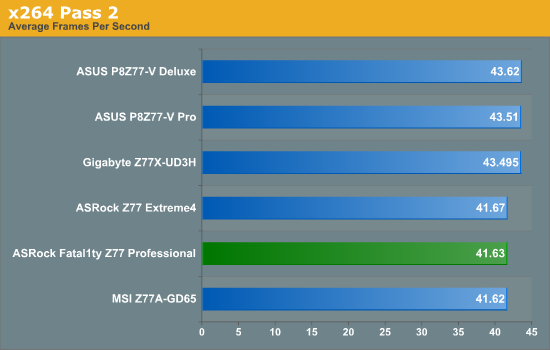
In yet another multithreaded test, the Professional does not break into the top half of the motherboard testing due to that speed deficit.










57 Comments
View All Comments
Chaitanya - Sunday, May 20, 2012 - link
I am wondering how many people actually use floppy drive in this day and age when OS can install RAID drivers off a USB thumb drive and motherboards can flash bios even without having a CPU installed.shabby - Sunday, May 20, 2012 - link
How else will people make floppy music? https://www.youtube.com/watch?v=LgfPYetWWJwNow wheres my printer port!
SlyNine - Sunday, May 20, 2012 - link
Thanks man, made my day!MonkeyPaw - Sunday, May 20, 2012 - link
That is awesome. Seems like something at the end of a Portal game.anirudhs - Sunday, May 20, 2012 - link
There used to be a time when booting into Linux was only possible using a floppy drive.CharonPDX - Thursday, May 24, 2012 - link
There used to be a time when booting into *ANY* OS was only possible using a floppy drive.Heck, Windows XP required a floppy drive to load storage drivers if you weren't using a supported storage controller. (Which could be worked around if you were really dedicated, but for the average home user...)
But since Windows Vista, we have no legitimate reason for the floppy drive to be internal as opposed to USB.
Many motherboard makers have a "legacy" motherboard available, that includes these things (plus serial and parallel ports,) for those customers that truly need them. But a gamer doesn't. I haven't *NEEDED* a floppy drive since at least 2006. Yes, I've *USED* one since, but a USB one works just fine for everything I've needed to use it for. Nearly the same for PATA. I can't think of any gamer that still has an PATA drive sitting around that they just *NEED* to use. Yeah, digging data off an old retired PATA drive is nice, but there are (SHOCK!) USB-to-PATA adapters that work just fine. (And since the absolute fastest PATA drives are barely equal to USB 2.0, the speed "hit" doesn't matter.)
I have a vintage computer collection, and use PATA, SCSI, even ESDI hard drives; along with 1.44 MB floppies, and even all the way back to 5.25" single-sided floppies, on a regular basis.
But I don't need support for any of them in my gaming PC. (Then again, I also bought the Abit AT7-MAX motherboard when it first came out, lacking PS/2, serial, and parallel ports when leaving them off was controversial. So maybe I'm just someone who is perfectly happy to ditch legacy on modern gear before others.)
It would be one thing if most boards still had them, but they don't. I don't even get the inclusion of the PS/2 port on many "gaming" boards these days. Does anyone still use a PS/2 keyboard or mouse on their modern "gaming" system? Haven't all gamers moved on to new fancy laser mice? (Or whatever the fad-of-the-minute is.)
DanNeely - Sunday, May 20, 2012 - link
when all the previous generation of boards yanked pata/floppy support there were enough people sending protest letters to convince most of the mobo makers to add it back for at least a few models.Personally I suspect they would've been better off jointly designing a pata/floppy pcie 1x card for the legacy device brigade.
Lazlo Panaflex - Monday, May 21, 2012 - link
Asrock has included IDE and floppy connectors in various boards since the Dual-VSTA days...this is nothing new. Plus, some people still have decent IDE stuff laying around (i.e. DVD burners). Some older versions of Ghost run off a floppy.SlyNine - Sunday, May 20, 2012 - link
The reason I bought the board was because AsRocks name is a much better commodity then it was back in the A64 days. I bought it because I AsRocks name had proven itself, and I needed a motherboard with a hella lot of HDD ports. This build has been on 24/7 and up for weeks at a time before rebooting for 6 months so I'm glad I got the motherboard afterall. All the Fatality 1 did was make me not want it. But again needed the 10 HDD ports.I don't care about the Fatality 1 on the board at all. Used to play a ton of FPS's and I'm very very good at them. To bad I moved to a place with crappy internet, and was forced to buy a LCD. Makes all the difference in the world!
AssBall - Monday, May 21, 2012 - link
So you moved somewhere with crappy internet and need 10 drives spinning all the time on an ATX board... because that's not pointless, inefficient, or unrealistic at all....